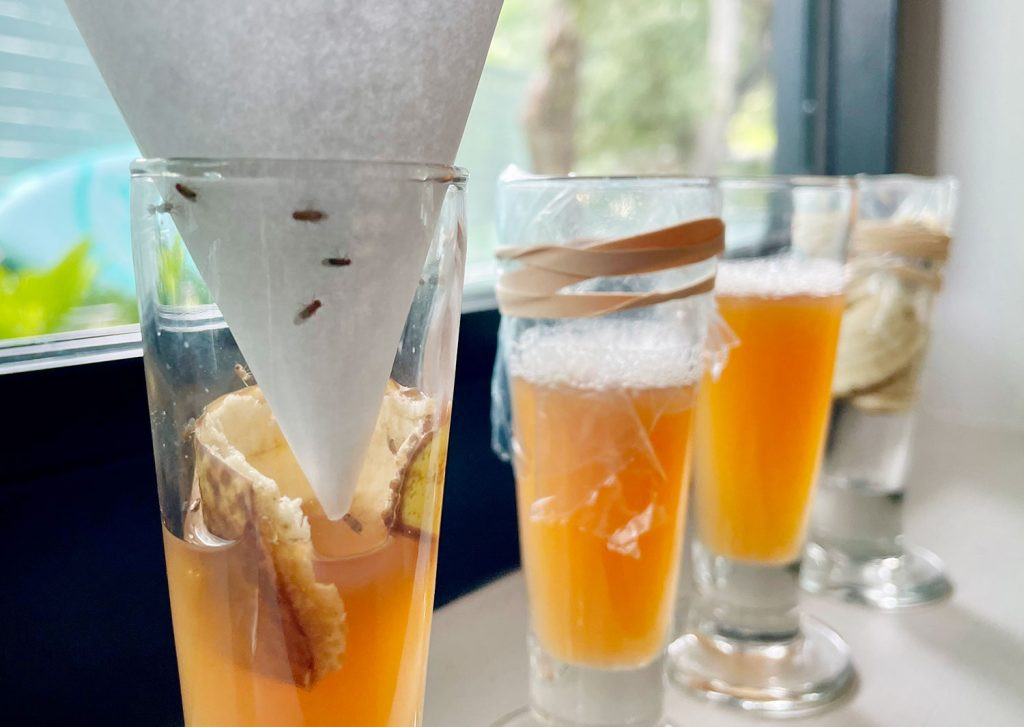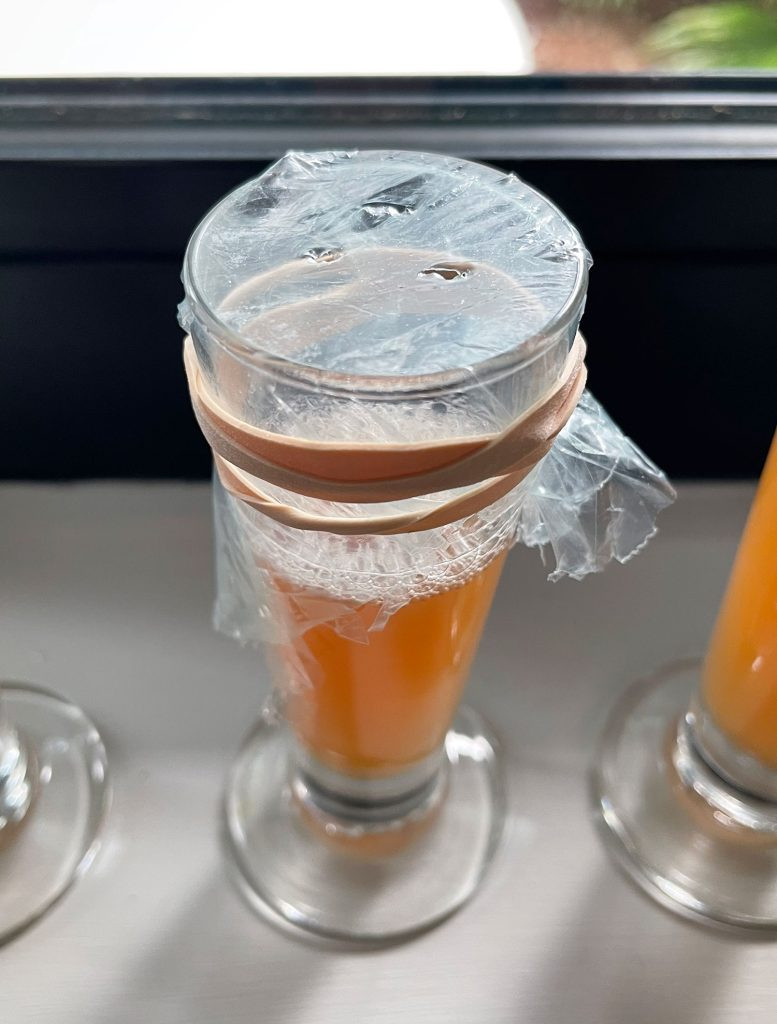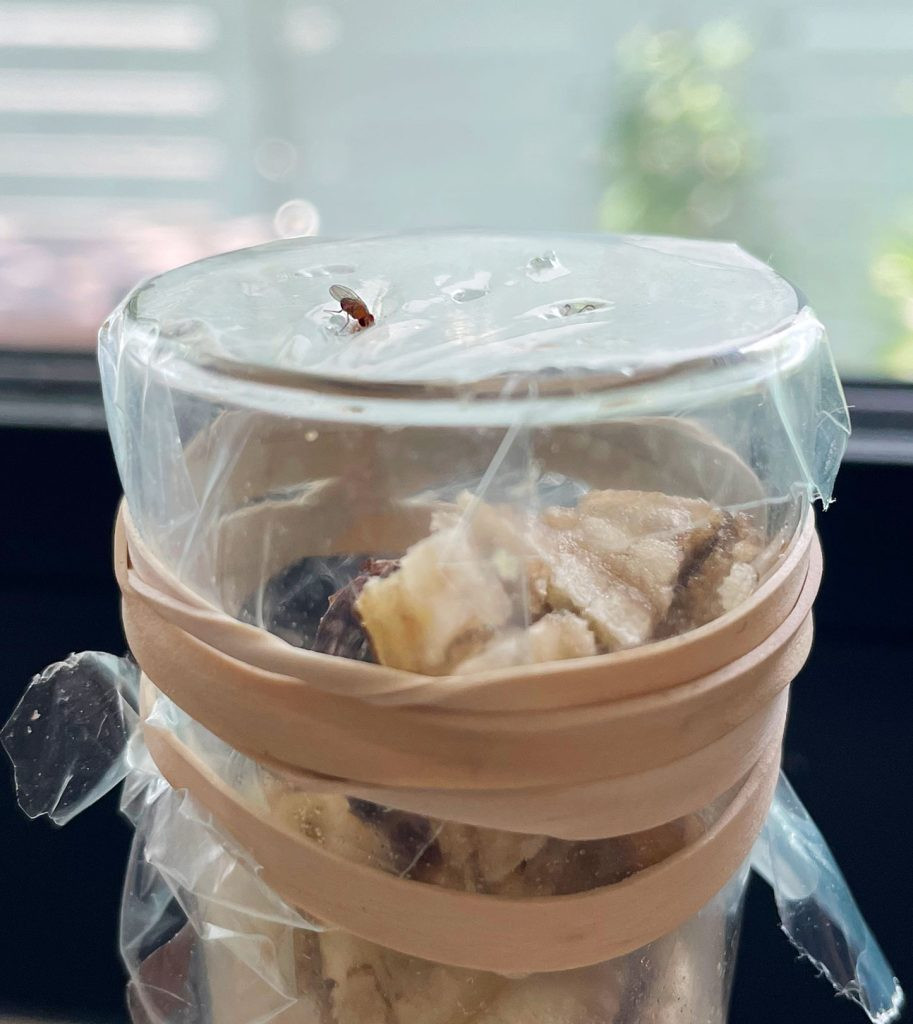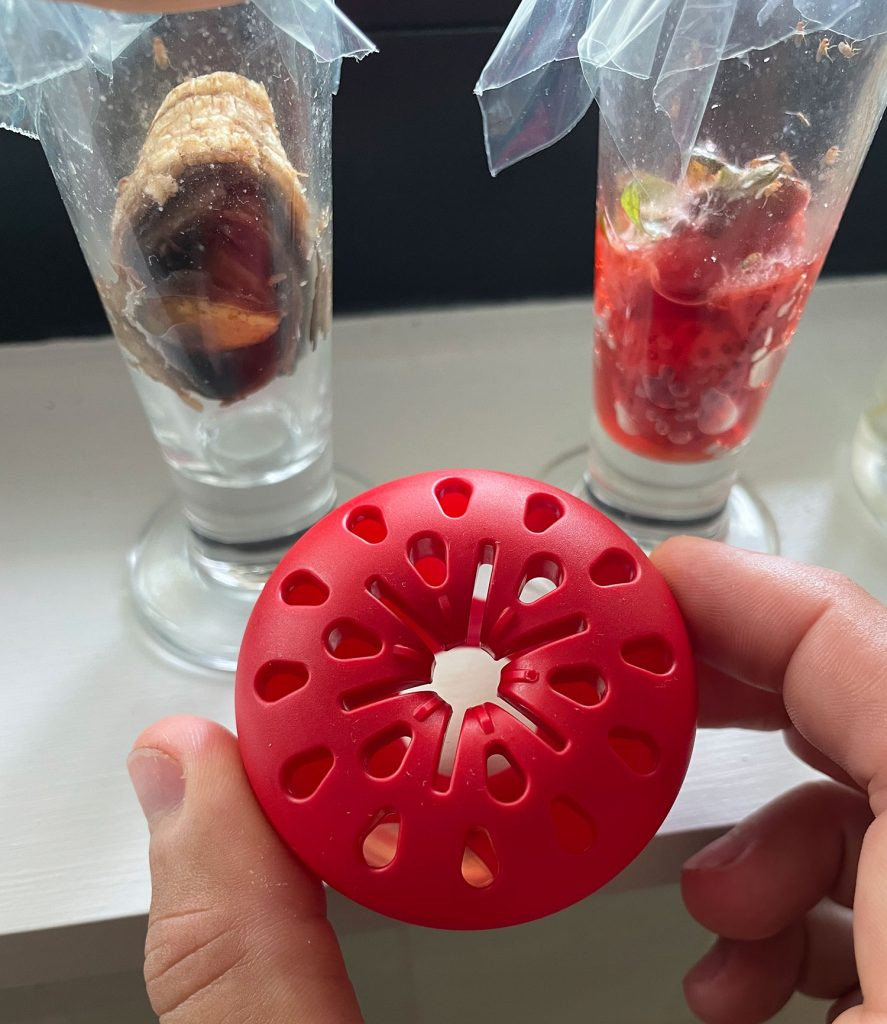Getting rid of tiny flies in your house, like fruit flies, doesn’t have to be a chore; flyermedia.net shows you how to eliminate them quickly with simple, budget-friendly solutions. These methods use everyday household items to effectively trap and eliminate these pests. Discover expert tips and tricks to keep your home fly-free and fresh. With these expert insights, say goodbye to unwanted guests and hello to a pristine, comfortable living space.
1. What Exactly Are Fruit Flies and Why Are They in My House?
Fruit flies are small, bothersome insects drawn to ripe or fermenting fruits and vegetables. They often invade homes seeking sugary substances found in overripe produce, spilled drinks, and even damp areas like kitchen drains, and with flyermedia.net, you can pinpoint the source and stop the infestation. These tiny flies, typically tan or brownish, can quickly multiply, turning a minor annoyance into a significant problem. Understanding their attraction to these environments is key to effectively eliminating them.
1.1 How Can You Differentiate Between Fruit Flies, Fungus Gnats, and Drain Flies?
Distinguishing fruit flies from similar pests like fungus gnats and drain flies is crucial for targeted control. Here’s a simple breakdown of their key differences:
| Feature | Fruit Flies | Fungus Gnats | Drain Flies |
|---|---|---|---|
| Appearance | Small flies, tan or brownish with red eyes | Small mosquito-like insects | Small fuzzy moths |
| Common Habitat | Fruit bowls, garbage cans, near food sources | Damp soil of houseplants | Sinks and drains |
| Breeding Source | Overripe fruit, spills, sugary substances | Overwatered plant soil | Organic matter in drains |
| Indication | Presence of ripe/rotting food | Overwatering houseplants, moldy soil | Dampness, slime in drains |
Identifying these differences helps in choosing the most effective removal strategy. For instance, if you spot tiny insects near your houseplants, you’re likely dealing with fungus gnats, which require different solutions than fruit flies.
 Fruit Flies Trapped In DIY Funnel Trap Method
Fruit Flies Trapped In DIY Funnel Trap Method
Effectively trapping fruit flies using a DIY funnel trap with ripe banana.
2. What Are the Best DIY Traps to Get Rid of Fruit Flies?
Creating your own fruit fly traps is a cost-effective and eco-friendly way to manage infestations, and flyermedia.net provides tested recipes that are both simple and effective. These traps typically involve attracting the flies with a sweet scent and then preventing them from escaping. Below are four proven DIY traps that use common household items:
2.1 How Do I Make a Funnel Trap for Fruit Flies?
The funnel trap is a classic and effective DIY method for catching fruit flies. It relies on the flies’ ability to enter a container easily but struggle to exit through a narrow opening.
Supplies Needed:
- Small clear jar or container with a narrow opening
- Piece of paper or cardstock
- Tape
- Scissors
- Apple cider vinegar (ACV)
Instructions:
- Choose Your Container: Select a small, clear container like a food jar or plastic bottle, preferably with a narrow opening.
- Add Apple Cider Vinegar: Pour a small amount of apple cider vinegar into the bottom of the container. The sweet, fermented scent will attract the fruit flies.
- Make Your Funnel: Roll a piece of paper or cardstock into a cone shape with a tiny opening at the tip. Secure the shape with tape. The opening should be just large enough for the flies to enter.
- Set Your Funnel: Place the paper cone into the opening of the container, ensuring it doesn’t touch the ACV. The funnel should fit snugly to prevent flies from escaping through any gaps.
- (Optional) Outdoor Release: Carefully move the trap outside without disturbing the funnel, then remove the funnel to release the trapped flies.
2.2 How Effective Is a Plastic Wrap Trap?
A plastic wrap trap is another easy and effective method to trap fruit flies. It uses a similar principle to the funnel trap, attracting flies with a sweet scent and trapping them under a layer of plastic wrap.
 DIY Fruit Fly Trap With Apple Cider Vinegar And Plastic
DIY Fruit Fly Trap With Apple Cider Vinegar And Plastic
A simple DIY fruit fly trap with plastic wrap and apple cider vinegar.
Supplies Needed:
- Small clear jar or container
- Rubber band
- Plastic wrap or plastic bag
- Toothpick
- Apple cider vinegar (ACV)
Instructions:
- Choose Your Container: Select a small, clear jar, cup, or container. A clear container helps you monitor the number of flies trapped.
- Add Apple Cider Vinegar: Pour apple cider vinegar into the container. The scent will lure the fruit flies. Old beer or wine can also be used.
- Cover with Plastic: Stretch plastic wrap tightly over the opening of the container and secure it with a rubber band.
- Poke Small Holes: Use a toothpick to poke a few small holes in the plastic wrap. The holes should be big enough for flies to enter but small enough to prevent easy escape.
- (Optional) Outdoor Release: Carefully take the trap outside without removing the plastic wrap, then remove the wrap to release the trapped flies.
2.3 Can Dish Soap Really Help Trap Fruit Flies?
A dish soap trap is a simple yet effective way to capture fruit flies by reducing the surface tension of the liquid, causing the flies to drown.
Supplies Needed:
- Small container, bowl, or dish
- Dish soap
- Apple cider vinegar (ACV)
Instructions:
- Add Apple Cider Vinegar: Fill the bottom of a small container, bowl, or dish with apple cider vinegar.
- Add Dish Soap: Squirt several drops of dish soap into the ACV and mix gently. The soap reduces the surface tension, making it difficult for the flies to escape once they land on the liquid.
2.4 How Do I Use Rotting Fruit as Bait for Fruit Flies?
Rotting fruit traps are particularly effective because they capitalize on the fruit flies’ natural attraction to decaying fruit.
 Fruit Fly Entering Plastic Wrap On DIY Trap
Fruit Fly Entering Plastic Wrap On DIY Trap
A fruit fly entering a DIY plastic wrap trap baited with rotting fruit.
Supplies Needed:
- Small glass jar or container
- Plastic wrap or paper funnel, depending on your chosen trap mechanism
- A small piece of fruit, such as a banana peel or apple slice
Instructions:
- Prepare the Trap: Use either the plastic wrap or funnel trap method.
- Add Fruit: Place a piece of overripe fruit, such as a banana peel, apple slice, or peach, inside the container.
- Monitor and Replace: Be prepared to replace the fruit every day or two to avoid unwanted odors in your kitchen.
2.5 What Is the Most Effective Bait for Fruit Fly Traps?
Based on testing, banana peels and strawberries have proven to be highly effective baits. The key is to use fruit that is very ripe or starting to decay, as the strong scent attracts more flies.
2.5.1 The Strawberry Advantage
Strawberries, especially when they are starting to rot, release a strong, appealing scent that fruit flies find irresistible. Place a rotting strawberry in a plastic wrap trap and monitor how quickly it attracts flies.
2.5.2 The Banana Peel Benefit
Banana peels, particularly from overripe bananas, also work exceptionally well. The strong, sweet smell is highly attractive to fruit flies.
3. Are There Any Store-Bought Fruit Fly Traps That Actually Work?
If DIY solutions aren’t your preference or you need a more discreet option, several store-bought fruit fly traps are available. These traps are designed to be both effective and easy to use, and flyermedia.net offers a curated selection based on performance and user reviews.
3.1 Terro Fruit Fly Traps: A Detailed Review
Terro Fruit Fly Traps are a popular choice, known for their ease of use and effectiveness. They contain a non-toxic lure that attracts fruit flies, trapping them inside the apple-shaped container.
Pros:
- Easy to set up and use
- Non-toxic lure
- Discreet design
Cons:
- May not work as quickly as some DIY traps
- Effectiveness can vary depending on the environment
 Terro Fruit Fly Apple Trap With No Fruit Flies In It
Terro Fruit Fly Apple Trap With No Fruit Flies In It
A Terro fruit fly trap placed alongside DIY traps for comparison.
4. How Can I Prevent Fruit Flies from Coming Back?
Preventing fruit flies from returning involves maintaining a clean environment and eliminating potential breeding sites, and flyermedia.net emphasizes proactive measures. Here are several effective strategies to keep these pests away:
4.1 Simple Preventative Measures
These straightforward practices can significantly reduce the likelihood of a fruit fly infestation:
- Clean Kitchen Surfaces: Regularly wipe down counters, stovetops, tables, and any other surfaces that may collect food residue or spills.
- Take Out Your Trash: Dispose of garbage regularly to prevent food scraps from becoming breeding grounds.
- Dispose of Overripe Fruit: Monitor your fruit bowl and discard any overripe or rotting fruit promptly.
- Wash Your Fruit: Wash produce as soon as you bring it home to remove any eggs or larvae.
- Store Produce in the Fridge: When possible, store fruits and vegetables in the refrigerator to slow down ripening and deter fruit flies.
- Clean Your Sink Drain: Regularly clean your sink drain to remove any food scraps that may attract fruit flies.
4.2 Why Is Kitchen Hygiene Crucial in Preventing Fruit Flies?
Maintaining a high level of kitchen hygiene is essential in preventing fruit flies. Fruit flies are attracted to even the smallest amounts of food residue, making it critical to keep surfaces clean and free of spills.
4.3 How Does Proper Food Storage Deter Fruit Flies?
Proper food storage plays a significant role in preventing fruit flies. Storing fruits and vegetables in airtight containers or in the refrigerator not only keeps them fresh longer but also prevents fruit flies from accessing them.
5. How to Eliminate Fruit Flies: Proven Strategies and Expert Tips
Eliminating fruit flies requires a combination of trapping and prevention strategies. To address a fruit fly infestation effectively, it’s important to target both the adult flies and their breeding sites. Here’s a comprehensive approach combining proven techniques with expert tips:
5.1 Effective Trapping Techniques
Trapping is a direct method to reduce the adult fruit fly population. By strategically placing traps, you can capture and eliminate these pests quickly.
5.1.1 DIY Traps: The Most Effective Methods
DIY traps are a cost-effective way to manage fruit fly infestations, using common household items to create simple yet effective solutions. As highlighted earlier, options include funnel traps, plastic wrap traps, dish soap traps, and rotting fruit traps.
5.1.2 Store-Bought Traps: When to Consider Them
Store-bought traps offer convenience and can be more discreet than DIY options. Brands like Terro provide traps with non-toxic lures that effectively attract and capture fruit flies. These traps are particularly useful if you prefer a ready-made solution or need a more visually appealing option.
5.2 Identifying and Eliminating Breeding Sites
Addressing breeding sites is crucial for long-term fruit fly control. By eliminating these sites, you prevent new generations of flies from emerging.
5.2.1 Common Breeding Areas in Your Home
Fruit flies can breed in various locations throughout your home, including:
- Fruit Bowls: Overripe or rotting fruit is a prime breeding ground.
- Garbage Cans: Food scraps in the trash can attract and sustain fruit fly populations.
- Drains: Damp, organic matter in drains provides an ideal breeding environment.
- Spills: Sugary spills or forgotten liquids under appliances can also serve as breeding sites.
5.2.2 Cleaning and Maintenance Practices
Regular cleaning and maintenance are essential to eliminate potential breeding sites. Key practices include:
- Wiping Down Surfaces: Regularly clean kitchen counters, tables, and stovetops to remove food residue.
- Taking Out Trash Regularly: Empty garbage cans frequently to prevent the accumulation of food scraps.
- Cleaning Drains: Flush drains with hot water and a brush to remove organic matter.
5.3 Advanced Prevention Strategies
Beyond basic cleaning, several advanced prevention strategies can further reduce the risk of fruit fly infestations.
5.3.1 Proper Fruit Storage
Storing fruit properly minimizes its appeal to fruit flies and slows down ripening.
- Refrigeration: Store fruits and vegetables in the refrigerator when possible to slow down ripening and reduce their attractiveness to fruit flies.
- Airtight Containers: Use airtight containers for storing fruit at room temperature to prevent fruit flies from accessing them.
5.3.2 Maintaining a Dry Environment
Fruit flies thrive in damp environments, so maintaining a dry environment can deter them.
- Fixing Leaks: Repair any leaks under sinks or in other areas to prevent moisture buildup.
- Ventilation: Ensure proper ventilation in kitchens and bathrooms to reduce humidity.
5.4 Natural Repellents and Deterrents
Certain natural substances can repel fruit flies without the use of harsh chemicals.
5.4.1 Essential Oils
Essential oils like peppermint, eucalyptus, and lavender can deter fruit flies. Dilute a few drops of essential oil in water and spray around potential entry points or breeding areas.
5.4.2 Herbal Solutions
Placing bowls of herbs like basil, mint, or rosemary near fruit bowls can also repel fruit flies. These herbs release natural compounds that fruit flies find unappealing.
6. How Do Environmental Factors Affect Fruit Fly Infestations?
Environmental factors significantly influence the presence and severity of fruit fly infestations, and flyermedia.net emphasizes the importance of understanding these elements for effective control. Temperature, humidity, and seasonal changes all play a role in the life cycle and behavior of these pests.
6.1 Temperature’s Role
Temperature is a critical factor in the life cycle of fruit flies. Higher temperatures accelerate their development, allowing them to reproduce more quickly.
- Optimal Breeding Conditions: Fruit flies thrive in warm environments, typically between 70°F and 80°F (21°C and 27°C).
- Increased Activity: In warmer months, fruit flies are more active and tend to reproduce at a faster rate.
6.2 Humidity’s Impact
Humidity also plays a role in fruit fly infestations. High humidity levels can create ideal breeding conditions, especially in areas where moisture accumulates.
- Favored Environments: Damp environments, such as kitchens and bathrooms, provide the moisture fruit flies need to breed.
- Mold Growth: High humidity can also promote mold growth, which can attract fruit flies.
6.3 Seasonal Variations
Fruit fly infestations often vary with the seasons. They tend to be more prevalent during the summer and fall when fruits are ripening and temperatures are warmer.
- Peak Infestation Times: Late summer and early fall are typically peak seasons for fruit fly infestations.
- Increased Availability of Food: During these seasons, an abundance of ripe fruits and vegetables provides ample food sources for fruit flies.
6.4 Strategic Environmental Control
To manage fruit fly infestations effectively, it’s important to control these environmental factors.
6.4.1 Temperature Regulation
Maintaining a cooler indoor temperature can help slow down the reproduction rate of fruit flies.
- Air Conditioning: Use air conditioning to keep indoor temperatures below the optimal range for fruit fly breeding.
- Ventilation: Ensure good ventilation to prevent the buildup of warm, stagnant air.
6.4.2 Humidity Management
Reducing humidity levels can help create a less favorable environment for fruit flies.
- Dehumidifiers: Use dehumidifiers in damp areas to lower humidity levels.
- Proper Ventilation: Ensure proper ventilation in kitchens and bathrooms to prevent moisture buildup.
7. Addressing Common Myths About Fruit Flies
Several misconceptions exist regarding fruit flies and their control, and flyermedia.net aims to debunk these myths to provide accurate and effective guidance. By understanding the truth behind these common beliefs, you can implement more successful strategies for managing fruit fly infestations.
7.1 Myth: Fruit Flies Appear Out of Nowhere
One common myth is that fruit flies spontaneously appear, seemingly out of thin air. In reality, fruit flies are almost always introduced into your home from an external source.
7.1.1 Reality: Introduced from External Sources
Fruit flies typically enter your home in one of two ways:
- Contaminated Produce: They may hitch a ride on fruits and vegetables brought in from the store, with eggs or larvae already present on the produce.
- Openings in Your Home: Adult fruit flies can fly indoors through open windows, doors, or small cracks and crevices.
7.1.2 Prevention: Inspecting and Cleaning Produce
To prevent fruit flies from entering your home, it’s important to inspect and clean produce thoroughly.
- Washing Produce: Wash fruits and vegetables as soon as you bring them home to remove any eggs or larvae.
- Storage: Store produce in the refrigerator to slow down ripening and prevent fruit flies from accessing them.
7.2 Myth: Fruit Flies Only Eat Fruit
Another misconception is that fruit flies exclusively feed on fruit. While they are certainly attracted to ripe and rotting fruit, their diet is more varied.
7.2.1 Reality: Varied Diet
Fruit flies are attracted to any source of sugar or fermenting organic matter, including:
- Sugary Spills: Spilled drinks, syrups, and other sugary substances.
- Fermenting Liquids: Beer, wine, and other fermented beverages.
- Garbage: Decaying food scraps in the trash.
- Drains: Organic matter in drains.
7.2.2 Prevention: Eliminating Food Sources
To control fruit flies, it’s essential to eliminate all potential food sources, not just fruit.
- Cleanliness: Maintain a clean kitchen by wiping down surfaces and cleaning up spills promptly.
- Garbage Management: Empty garbage cans regularly and ensure they are tightly sealed.
- Drain Maintenance: Clean drains regularly to remove organic matter.
7.3 Myth: One Fruit Fly Isn’t a Problem
Some people believe that the presence of a single fruit fly isn’t a cause for concern. However, even one fruit fly can quickly lead to a full-blown infestation.
7.3.1 Reality: Rapid Reproduction
Fruit flies have a rapid reproductive cycle, with females capable of laying hundreds of eggs in their short lifespan. These eggs can hatch within as little as 24 hours, leading to a population explosion.
7.3.2 Action: Immediate Response
To prevent a fruit fly infestation, it’s important to take immediate action at the first sign of their presence.
- Trapping: Set up traps to capture and eliminate adult fruit flies.
- Source Elimination: Identify and eliminate potential breeding sites.
8. Real-Life Scenarios: Tackling Fruit Fly Infestations Effectively
To illustrate effective fruit fly control, let’s examine several real-life scenarios where specific strategies can be applied, provided by flyermedia.net. These examples showcase how to identify the source of the infestation and implement targeted solutions for different situations.
8.1 Scenario 1: The Fruit Bowl Problem
Situation: A homeowner notices a sudden increase in fruit flies around their fruit bowl, which contains bananas, apples, and oranges.
Source Identification: The primary source is likely the overripe fruit in the bowl, particularly the bananas, which tend to ripen quickly.
Action Plan:
- Remove Overripe Fruit: Discard any overripe or rotting fruit immediately.
- Wash Remaining Fruit: Wash the remaining fruit to remove any potential eggs or larvae.
- Store Fruit Properly: Store fruit in the refrigerator or in airtight containers.
- Set Up Traps: Place fruit fly traps near the fruit bowl to capture any remaining adult flies.
8.2 Scenario 2: The Drain Dilemma
Situation: A restaurant owner notices fruit flies congregating near the kitchen sink drains, despite regular cleaning efforts.
Source Identification: The most likely source is the accumulation of organic matter in the drains, providing a breeding ground for the flies.
Action Plan:
- Deep Clean Drains: Use a drain brush and hot water to scrub the inside of the drains thoroughly.
- Enzyme Cleaner: Pour an enzymatic drain cleaner down the drains to break down organic matter.
- Regular Flushing: Flush the drains regularly with hot water to prevent buildup.
- Trap Placement: Place traps near the drains to capture adult flies emerging from the drains.
8.3 Scenario 3: The Grocery Store Import
Situation: A family consistently battles fruit flies, even after taking preventive measures. They suspect the flies are coming from the grocery store.
Source Identification: The source is likely contaminated produce brought in from the grocery store.
Action Plan:
- Inspect Produce: Carefully inspect all produce for signs of fruit flies or their eggs before bringing it into the house.
- Wash Immediately: Wash all fruits and vegetables as soon as they are brought home.
- Store Properly: Store produce in the refrigerator or in airtight containers.
- Communicate with Store: Inform the grocery store about the issue so they can take steps to address it.
9. What Are the Potential Health Risks Associated with Fruit Flies?
While fruit flies are generally considered more of a nuisance than a health hazard, they can pose some minor health risks, as highlighted by flyermedia.net. Understanding these risks can help you prioritize effective control measures.
9.1 Contamination of Food
Fruit flies can contaminate food by transferring bacteria and other microorganisms from unsanitary surfaces to your food.
9.1.1 Bacteria Transfer
Fruit flies often breed in decaying organic matter, such as garbage and drains, which are teeming with bacteria. When they land on food, they can transfer these bacteria, potentially leading to foodborne illnesses.
9.1.2 Allergic Reactions
In rare cases, some individuals may experience allergic reactions to fruit flies or their waste products.
9.2 Impact on Food Quality
Even if they don’t directly cause illness, fruit flies can affect the quality and appeal of food.
9.2.1 Aesthetic Issues
The presence of fruit flies can make food unappetizing.
10. FAQs About Getting Rid of Tiny Flies
Here are some frequently asked questions about eliminating tiny flies in your home:
- What attracts fruit flies the most? Fruit flies are most attracted to ripe or fermenting fruits and vegetables, sugary spills, and damp, organic matter.
- How quickly can a fruit fly infestation occur? Fruit flies can multiply rapidly, with females laying hundreds of eggs that hatch within 24 hours, leading to a quick infestation.
- Are DIY fruit fly traps effective? Yes, DIY traps using apple cider vinegar, dish soap, or rotting fruit can be very effective in capturing fruit flies.
- Can fruit flies bite humans? No, fruit flies do not bite humans. They are primarily attracted to sugary substances.
- How do I prevent fruit flies from breeding in my sink drain? Regularly flush your sink drain with hot water and a drain brush to remove organic matter.
- Are store-bought fruit fly traps worth the cost? Store-bought traps can be effective, especially if you prefer a discreet, ready-made solution.
- Do fruit flies carry diseases? While they are not major disease carriers, fruit flies can transfer bacteria to food surfaces.
- Can essential oils repel fruit flies? Yes, essential oils like peppermint, eucalyptus, and lavender can help repel fruit flies.
- Is it necessary to call a professional exterminator for fruit flies? In most cases, fruit fly infestations can be managed with DIY or store-bought traps and preventive measures.
- What is the lifespan of a fruit fly? The lifespan of a fruit fly is about 40 to 50 days.
Ready to say goodbye to those pesky tiny flies for good? Visit flyermedia.net today for even more expert tips, detailed guides, and the latest innovations in pest control. Don’t let fruit flies take over your home—take action now and enjoy a cleaner, fresher living space. Explore our resources, connect with our community, and discover the solutions you need to keep your home fly-free all year round. Your journey to a pest-free life starts here at flyermedia.net.